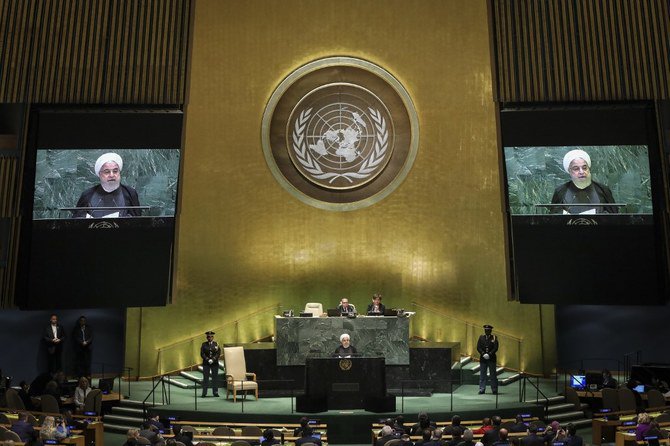
- ARAB NEWS
- 06 Jul 2025

Since the rise of the clerics in 1979, the Iranian regime has relied on a two-pronged strategy to advance its revolutionary ideals and achieve its hegemonic ambitions in the region.
The first part of the strategy is to incite instability, conflict or a civil war in another country. This is achieved through Tehran’s sectarian agenda of pitting the Shiite communities against the Sunnis, and through sponsoring, financing and arming militia, rebel, and terror groups in a foreign nation.
After this objective of creating instability and chaos has been accomplished, the second prong of the mullahs’ strategy comes into play: offering to be part of the “solution” through a “peace plan” and leading such an initiative to stabilize the conflict-affected nation.
Generally, the targeted country sees no alternative to surrendering to Iran’s plan, because it if doesn’t Tehran will continue to wreak havoc on that nation.
It is through the second process that Iran ingrains itself in the security, political and economic system of the targeted nation and becomes an integral part of its decision-making process.
The Islamic Republic first implemented this two-pronged strategy in Lebanon in early 1980s. The Islamic Revolutionary Guard Corps (IRGC) and its elite branch, the Quds Force, infiltrated Lebanon and consolidated the Shiite militia.
Tehran first attempted to destabilize the region by harassing and sabotaging ships, as well as launching missile and drone attacks
This resulted in the creation of Hezbollah as Tehran poured billions of dollars into Lebanon and provided advanced weapons to its militants. Soon, the Arab country was dragged into a decade-long civil war. After the Lebanese government was significantly weakened and after tens of thousands of people lost their lives, Iranian leaders offered to be part of resolving the Lebanese crisis.
What was the outcome? Iran’s powerful proxy and force, Hezbollah, became an officially recognized political party in Lebanon and became part of the government after the civil war ended. In 1992, Hezbollah participated in Lebanon’s election and won several seats in the parliament. This meant that Iran has a say in Lebanon’s domestic and foreign policy through its proxy.
The same process occurred in Iraq. Iran sponsored a conglomerate of militias known as the Popular Mobilization Forces. These militias ratcheted up the conflict in Iraq by engaging in various crimes against civilians, including summary executions, disappearances, torture, the use of child soldiers, indiscriminate attacks, and unlawful restrictions on the movement of people fleeing the fighting. The militias became skilled at exploiting religion and using sectarianism as a tool to gain power and further Iran’s parochial, religious and political ambitions.
In the second step, the Iranian regime pushed the Iraqi government into recognizing these militias as “legitimate” groups, incorporating them into the state apparatuses and making the Iraqi government allocate wages and ammunition for them. Currently, the Iraqi government pays for the PMF.
In Syria, the Iranian regime again assembled a coalition of Shiite forces and militias which came to Syria from Iraq, Pakistan, Afghanistan and Lebanon. Tehran spent approximately $100 billion, roughly between $15 and $20 billion a year, further destabilizing the country. Then Iran offered to be part of the solution to resolve the Syrian civil war. After several years of bloody civil war, many of the Shiite militias in Syria have become the bedrock of Syria’s socio-political and socio-economic infrastructures. Iran’s Islamic Revolutionary Guard Corps and the Quds Force are also enjoying a military presence in Syria and the IRGC has established permanent military bases across Syria.
Another country that has become the target of Iran’s opportunistic two-pronged and hypocritical strategy is Yemen. Iran’s goal here was anchored in creating a political reality out of the Houthis, as it did with Hezbollah in Lebanon. Through its delivery of advanced weapons and financial assistance it emboldened and empowered the Houthis. Now Iran exploits its ties with the Houthis as additional leverage against Saudi Arabia and its allies. This leverage can be used by the Iranian regime as a strategic bargaining chip in future negotiations or to pressure Riyadh to change direction.
Iran’s theocratic establishment is pursuing the same dual strategy in the Arabian Gulf. Tehran first attempted to destabilize the region by harassing and sabotaging ships, as well as launching missile and drone attacks.
Now the Iranian leaders are offering to be part of the solution again. At the United Nations General Assembly, the Iranian President Hassan Rouhani called on the regional countries to join his government’s “peace plan,” which is labeled as the “Coalition of Hope.” Rouhani said that with such a maritime group, “the free flow of oil and other energy resources could be guaranteed, provided that we consider security as an umbrella in all areas for all the countries.”
But what is the catch? Tehran’s maritime security initiative excludes other powerful countries, including the United States. In other words, the regime is seeking to be an unrestrained overlord in the Gulf.
The Iranian regime is the problem, not the solution. For almost four decades, Iran’s ruling mullahs have sowed the seeds of war in other nations.